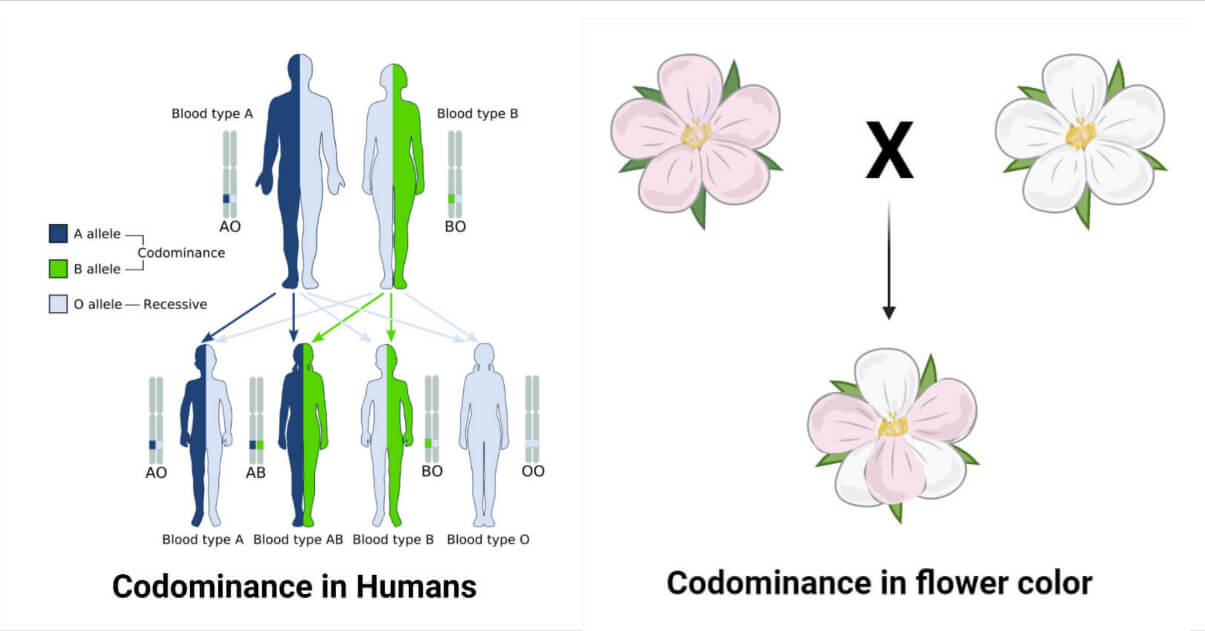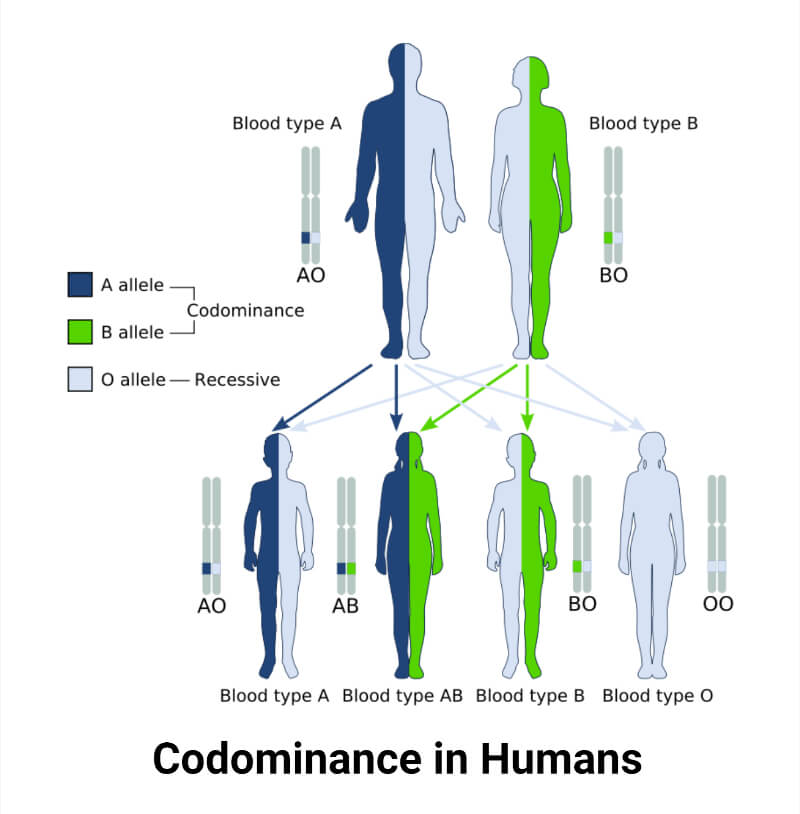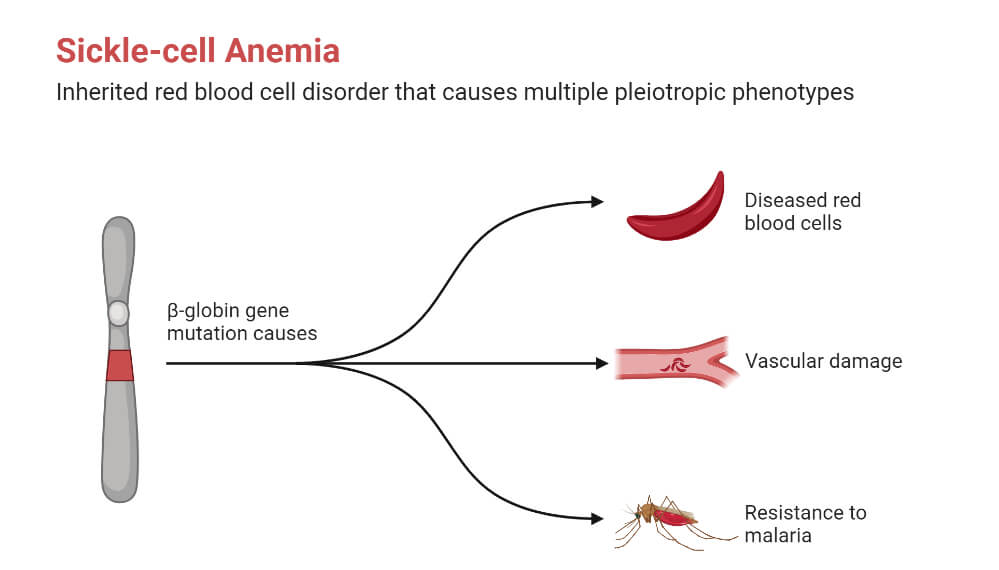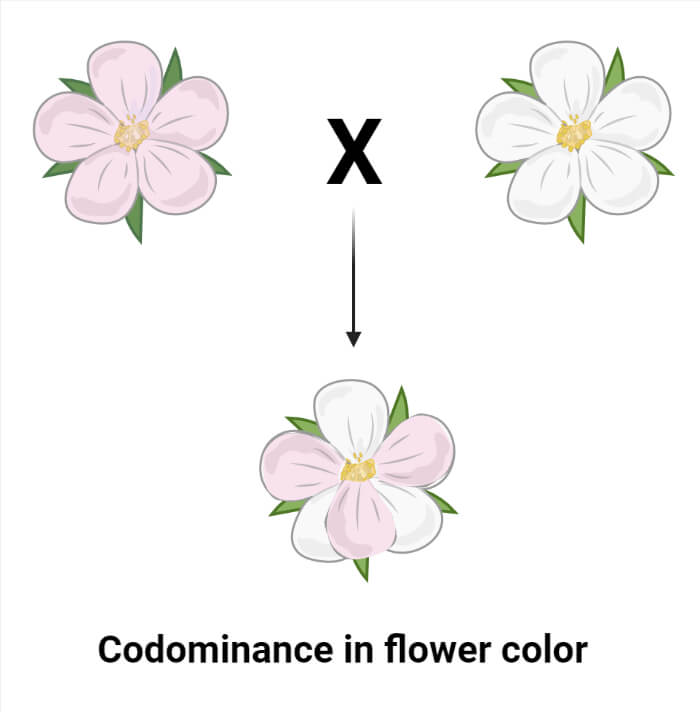Codominance is a type of inheritance in which the expression of the two alleles (dominant and recessive) of the same gene results in the appearance of both traits in an individual instead of only one being dominant.
The concepts of dominance and recessiveness are fundamental to the understanding of Mendelian inheritance.
However, when a gene has multiple alleles, not all of the alleles will necessarily follow simple dominance because the gene may contain one or more alleles that are dominant or recessive.
In such cases, the concepts of incomplete dominance and codominance come forth.

Codominance occurs when two gene products, such as different transcripts from the two alleles, different proteins from cellular processing of the transcripts, or different metabolites specifically linked to the enzymatic activity of the transcripts or proteins exist in roughly equal amounts at a locus in a heterozygote.
Since the heterozygote displays the traits of both homozygotes, codominance is simply the absence of dominance. As a result, phenotypes associated with heterozygote genotypes differ significantly from those associated with either homozygous genotype.
Symbolism for codominant alleles
For codominant alleles, all upper-case base symbols with different superscripts are used.
The upper case letters indicate that each allele can express itself to some degree even when in the presence of its alternative allele (heterozygous).
Codominance in Animals
1. The coat color of the Shorthorn breed of cattle is a prime example of codominance.
When a cattle with a red coat (CRCR) and a cattle with a white coat (CWCW) are crossed, the F1 heterozygote or hybrid possesses a roan coat (CRCW).
The red and white hairs of a roan coat are present in distinct regions, but no hair has an immediate between the two colors.
2. The roan gene is responsible for the roan coat color observed in horses.
Red roan, bay roan, and blue roan are the three varieties of roans found in horses.
Codominance in Humans
1. The alleles governing the M-N blood group system in humans are codominant and can be
represented by the symbols LM and LN.
The base letter L is assigned in honor of its discoverers (Landsteiner and Levine).
Here, three blood groups are possible: M, N, and MN, and these are determined by the genotypes LMLM, LNLN, and LMLN, respectively.
The presence of an immunological antigen on the surface of red blood cells is represented by blood groups.
People of the LMLN genotype have both antigens.
In the following summary chart, agglutination is represented by (+) and non-agglutination by (–) sign:
| Reaction with Antisera | Reaction with Antisera | ||
| Genotype | Anti–M | Anti–N | Blood group (Phenotype) |
| LMLM LMLN LNLN | + + – | – + + | M MN N |
2. Codominance is also present in the human ABO blood group system.
The three alleles in the system are A, B, and O.
- In relation to O, A and B are equally dominant.
- Genotype AA or AO is possible for blood group A.
- Genotype BB or BO is possible for blood group B.
However, neither blood group A nor blood group B exhibits dominance over the other. Therefore, individuals with the genotype AB exhibit the phenotypic traits of blood group A and blood group B.

3. The inheritance pattern of sickle-cell anemia in humans exhibits incomplete dominance at the cellular or cell shape level and codominance at the molecular, i.e., hemoglobin level.
The gene pair HbA (for hemoglobin A) and HbS (for hemoglobin S) affects the oxygen transport molecule hemoglobin.
The three genotypes exhibit various phenotypes, as follows:
- HbAHbA:
- Normal.
- Red blood cells never sickled.
- Contain one type of hemoglobin, i.e., hemoglobin A.
- HbSHbS:
- Severe, often fatal anemia.
- Red blood cells sickled-shaped.
- Contain one type of hemoglobin, i.e., hemoglobin S.
- HbAHbS:
- No anemia.
- Red blood cells sickle shaped only under abnormally low oxygen concentrations.
- Contain both types of hemoglobins, i.e., hemoglobin A and hemoglobin S.
- Thus, in regard to anemia, the HbA allele is dominant.

When present as a homozygote (HbSHbS), the HbS allele operates as a lethal gene, which means that it results in the death of the bearer. Homozygotes die with fatal anemia before reaching sexual maturity.
Codominance in Plants
- Codominance can be observed in rhododendrons that produce flowers with two different color phenotypes. Flowers with both red and white petals are produced by the simultaneous expression of red and white genes for flower color.
- When a white-colored Camellia and a red-colored Camellia are crossed, both red-colored petals and white-colored petals are formed due to codominance exerted by both dominant alleles of red and white petal color.

Significance of Codominance
- An improvement in both the genetic diversity of a population and an individual’s fitness.
- Codominant markers enable the differentiation of heterozygotes from homozygotes and the determination of genotypes and allele frequencies at loci.
References
- Biologywise. (2022). Codominance Explained with Examples.
Accessed from: https://biologywise.com/codominance-explained-with-examples - Britannica, T. Editors of Encyclopaedia. (2020). Codominance.
Accessed from: https://www.britannica.com/science/codominance - Cook, J. (2013). Genes in Families. Emery and Rimoin’s Principles and Practice of Medical Genetics. 1-18. DOI: 10.1016/B978-0-12-383834-6.00008-2.
- National Human Genome Research Institute (NIH). (2022). Codominance. Accessed from: https://www.genome.gov/genetics-glossary/Codominance
- Verma P.S. and Agarwal V.K. (2005). Codominance. In Cell Biology, Genetics, Molecular Biology, Evolution and Ecology. Multi-color Edition. S. Chand & Company Ltd. Ram Nagar, New Delhi, pg. 32-34. ISBN 81-219-2442-1
- Wageningen University and Research. (2022). Characteristics of genetic markers: Codominance in alleles. Accessed from: https://www.wur.nl/en/show/Characteristics-of-genetic-markers-Codominance-of-alleles.htm
- X. Xia. (2013). Codominance. In Brenner’s Encyclopedia of Genetics (Second Edition). Academic Press, pg. 63-64. ISBN 9780080961569. https://doi.org/10.1016/B978-0-12-374984-0.00278-3.
